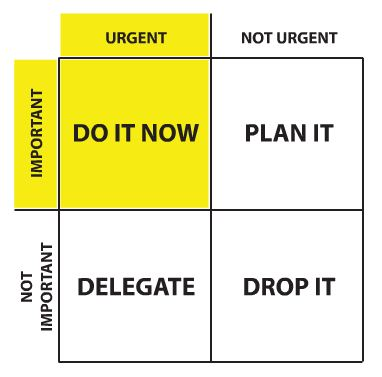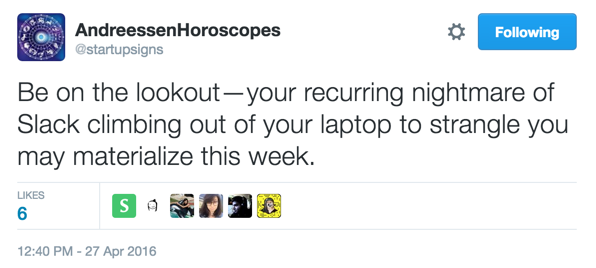I remember the first time I heard of Slack at the start of 2014. I had never used Hipchat, so the aspect of a collaborative team chat tool didn’t resonate with me. However, I was immediately drawn to the playful aesthetic and ease of use. The attention to detail in the design spoke to me directly. Soon enough, I began looking for excuses to use it.
When I joined Segment in the August of 2014, the team was using Hipchat. Segment, a close knit family where we had rooms dedicated for the lulz and individuals who took pride in their obscure gif abilities (pride that is definitely deserved), having Hipchat on my laptop and phone was like having my best friends with me at all times. I never felt truly alone and finding some laughter was always a few taps away.
One of my more memorable early projects was to port our beloved Hermes (our version of a hubot) to Slack’s RTM API. Being early Slack fanatics, me and fellow success engineer (at the time) de-prioritized everything else to work on this. Soon thereafter, we were able to migrate our entire chat over to Slack.

When Segment Met Slack
Cue to the honeymoon period with Slack. Around every corner in Slack’s interface, even though it was more or less the same as Hipchat, there was something to delight me. Again, I was drawn to the colorful design and the whimsy copy that made even the dullest conversation about product updates seem exciting and fun. And on top of that, adding custom emojis (especially ones of our colleague’s faces) added yet another dimension of trolling that made everyone feel warm and loved.
Segment was in love with Slack. We adopted naming conventions for channels that reflected our organizational structure. At one point we were adding five or six new channels a day. To stay on top of the pulse of the company, I created FOMO Channel Bot that would update into a dedicated channel (#feed-new-channel) whenever a new channel was created.
How to Lose Slack in 10 Days
All good things must come to an end. Slack fever definitely got a grip on us, and many of us openly griped that the commotion in Slack is interfering with our ability to focus on our jobs. And startups, by sheer nature of odds being stacked against us and our real edge against incumbents is our ability to focus and solve one problem really well, this was a problem.
We’re fans of using the Eisenhower Box as a framework to know how to approach tasks. But with Slack, every knock-brush carries the same weight—and we’re forced to check the message and parse it mentally to understand its urgency and importance. We weren’t able to separate the signal from the noise.

If you needed to monitor Slack every few minutes just to make sure you weren’t missing out on anything important or critical to your job, then it’s very difficult to find longer, uninterrupted periods of time for you to focus.

Independently, our fearless leader and CEO, Peter, sent out a company wide survey asking about the main sources of distraction. While not seeking to scapegoat Slack as a reason for distractions, it became clear that group Slack channels were one unanimous culprit. As such, we’ve made a few changes regarding Slack.
Love, Slacktually
Jeff Bezos famously said that any team should be small enough that it could be fed with two pizzas (just get bigger pizzas, amirite?). We believe that this limitation extends into the digital world, as well.
Group channels with more than 20 members consistently devolved into a stream of semi-irrelevant messages that encouraged “bike shedding” (a managerial phenomenon when everybody voices their opinions when the subject matter at stake is something trivial, like painting a bike shed), which ultimately found no actionable recourse due to lack of clear ownership and accountability. Having large group channels made it super easy for someone to join, voice their opinion, and then bounce. And we all know opinions are like assholes—everyone has one (and Kim Kardashian keeps putting hers on the Internet).
We’ve effectively made away with all of our large group channels by turning them into private channels (with the exception of #hq, #sf, #random, and a few other non-work related ones). Now, if you want to voice your opinion on something, identify the team lead and reach out to them 1-on-1. If you want it to be carefully reviewed, then email is best. If it’s urgent, then opt for Slack direct message.
Moreover, each group channel should have a clear purpose. So be more judicious about creating a new group channel and archiving old channels. For example, if there are two channels that intend to serve purposes that overlap, then let’s archive one of them.
Other Tips:
Mute channels liberally: Chances are, every new message in that channel won’t help you do your job. I mute all of the channels that I don’t really need, but would like to review at the end of each day. If something is really important, you will know about it.
When to Slack vs. when to Email: does your message require immediate attention? If so, Slack. Does your message require some thinking and discussion for more than one other person? If so, email.
Use DND and Away settings liberally: If you need some uninterrupted time to work, set yourself as away. Another productivity hack I like to employ is to block off hours at a time on my calendar.
Slackless in Seattle
Hopefully these tips have helped your team think critically about how you’re using Slack. And if not, at least prompted you to be more aware of how you’re using it. Teams of different sizes have their own managerial issues, many of which find ways to manifest themselves in Slack. Also, the ways organizations structure themselves present different challenges when trying to use a collaborative chat tool to efficiently disseminate and allocate information.